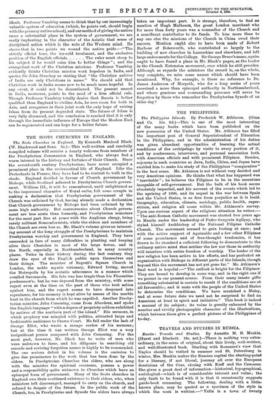THE PHILIPPINES.
The Philippine Islands. By Frederick W. Atkinson. (Ginn and Co. 10s. 6d.)—This is one of the most interesting of the many books which have been published on the new possession of the United States. Mr. Atkinson has filled the important post of General Superintendent of Education In the Philippines, and in the administration of hie duties was given abundant opportunities of learning the actual conditions of the archipelago by visits to every portion of it, and by conferences, interviews, and personal association both with American officials and with prominent Filipinos. Besides, sojourns in such countries as Java, India, China, and Japan have enabled him to make his study of the Philippines "comparative" in the best sense. Mr. Atkinson is not without very decided and very American opinions. He thinks that what has happened was " inevitable " ; he believes the Filipinos to be in the meantime Incapable of self-government. But the bulk of his book seems absolutely impartial, and his account of the events which led to the uprising of 1896, and its sequel in the war between Spain and the United States, is as free from prejudice as it is lucid. Geography, education, climate, sociology, public health, super- stition, and religion all come within Mr. Atkinson's survey, Upon one curious aspect of the religious situation he writes :— "The anti-Roman Catholic movement was started two years ago in Manila under the leadership of Padre Gregoria Agilpay, who styled himself Archbishop of the National Filipino Catholie Church. The movement seemed to gain footing at once; and with the active support of Aguinaldo and a few other Filipinos of some prominence and of free-thought tendencies, it has drawn to its standard a sufficient following to demonstrate to the ordinary native mind that neither the law nor those in authority will interfere with entire freedom of worship. The leader of the new religion has been active in his efforts, and has perfected an organisation with Bishops in different parts of the Islands, though beyond this the movement has not yet gone far." Mr. Atkinson's final word is hopeful :—" The outlook is bright for the Filipinos. They are bound to develop in some way, and in the right one if we persist in our present course. From their many innate gifts something substantial is certain to result if the conditions are at all favourable ; and it rests with the people of the United States to determine the conditions. We have scratched a Malay, and at some future date we need not be surprised to find an American at least in spirit and initiative." This book is indeed a manual of its subject ; its value is greatly enhanced by the number and vividly photographic character of the illustrations, which between them give a perfect picture of the Philippines of to-day.






























































 Previous page
Previous page